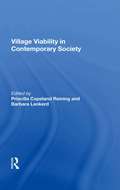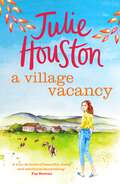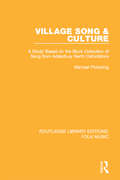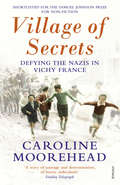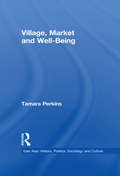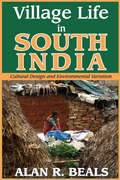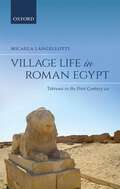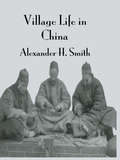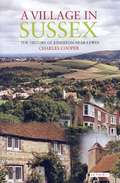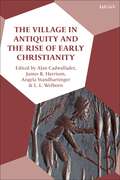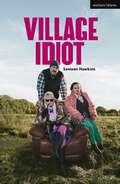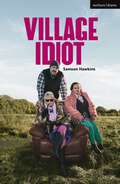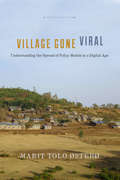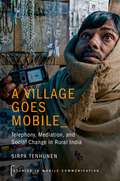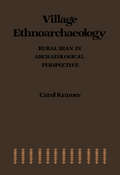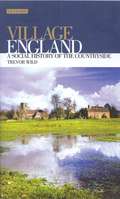- Table View
- List View
Village Viability In Contemporary Society (Anthropological Society Of Washington Ser.)
by Priscilla Copeland ReiningThis book on the important question of village viability arose from several organizational innovations. It presents the important experience of intensive village studies conducted by anthropologists and sociologists and describes it with the views of development economists and administrators.
Village Viability In Contemporary Society
by Priscilla Copeland ReiningThis book on the important question of village viability arose from several organizational innovations. It presents the important experience of intensive village studies conducted by anthropologists and sociologists and describes it with the views of development economists and administrators.
A Village Vacancy: The Laugh-out-loud New Book From The Bestselling Author Of A Village Affair
by Julie Houston'A Village Vacancy is a tour de force of beautiful, funny and emotional storytelling' Fay KeenanFrom the bestselling author of A Village Affair comes a warm, witty, wonderful new Westenbury tale... As the Yorkshire village of Westenbury mourns the loss of one of their own, the women can't help but contemplate who will fill the vacancy in handsome widower David's life.Meanwhile, Grace Stevens has decided to move on without her good-for-nothing husband. Right now, she needs to focus less on men and more on wrangling with her unruly class of pre-teens.And thankfully, there's plenty to keep her occupied. Between an accidental dalliance with a pupil's dad, helping close down a drug ring and keeping up with her closest girlfriends, Grace is busier than ever.But as she spends more time with David, her determination to go it alone begins to waver...Praise for Julie Houston: 'A warm, funny story of sisters and the secrets they keep' Sheila O'Flanagan'Warm, funny and well written, with a page-turning plot, this book has everything! I loved it!' Katie Fforde'Julie Houston at her best – heartfelt and hilarious' Sandy Barker'Laugh-out-loud hilarious and heartwarming!' Mandy Baggot'This book is an absolute gigglefest with characters you'll fall in love with!' Katie Ginger
Village Song & Culture: A Study Based on the Blunt Collection of Song from Adderbury North Oxfordshire (Routledge Library Editions: Folk Music)
by Michael PickeringOriginally published in 1982. The songs on which this study is based were once vibrant in the throats and ears and minds of living people. This book examines the songs and their meanings in relation to the lives of those people, and relates them to the cultural tradition and practice of which they were an integral part. The art of village song represents a sense of cohesiveness and mutual identity around local patterns of kinship, social groupings, territorial orientations and cultural relationships. The actual ways in which songs were part of village life is of course highly problematic, but this book endeavours, most of all, to present an understanding of the place of song in the social life of villagers.
Village Song & Culture: A Study Based on the Blunt Collection of Song from Adderbury North Oxfordshire (Routledge Library Editions: Folk Music)
by Michael PickeringOriginally published in 1982. The songs on which this study is based were once vibrant in the throats and ears and minds of living people. This book examines the songs and their meanings in relation to the lives of those people, and relates them to the cultural tradition and practice of which they were an integral part. The art of village song represents a sense of cohesiveness and mutual identity around local patterns of kinship, social groupings, territorial orientations and cultural relationships. The actual ways in which songs were part of village life is of course highly problematic, but this book endeavours, most of all, to present an understanding of the place of song in the social life of villagers.
A Village Secret: Summer 2022's Most Page-turning, Uplifting Read, From The Bestselling Author Of A Village Affair
by Julie HoustonWhen Jennifer goes up to Cambridge University with her head full of the Romantic Poets, she never dreams that she will find her very own Byron. But then she meets gorgeous actor Laurie Lewis, and finds herself living a real-life love poem.Fifteen years and two children later, Jennifer and Laurie's relationship is starting to feel more like an epic tragedy. After a series of revelations turn her world upside down, Jennifer will do anything to keep her family together – even if it means moving hundreds of miles away to Laurie's childhood home in Westenbury, Yorkshire.As she reluctantly enters into village life – complete with interfering in-laws, new friends and a surprise delivery of alpacas – Jennifer is amazed to find herself feeling happy for the first time in years. But the village holds one last, devastating secret and Jennifer must decide once and for all what she wants her future to hold.Praise for Julie Houston: 'A warm, funny story of sisters and the secrets they keep' Sheila O'Flanagan'Warm, funny and well written, with a page-turning plot, this book has everything! I loved it!' Katie Fforde'Julie Houston at her best – heartfelt and hilarious' Sandy Barker'Laugh-out-loud hilarious and heartwarming!' Mandy Baggot'This book is an absolute gigglefest with characters you'll fall in love with!' Katie Ginger
Village of Secrets: Defying the Nazis in Vichy France (The\resistance Trilogy Ser. #2)
by Caroline MooreheadA SUNDAY TIMES TOP FIVE BESTSELLERSHORTLISTED FOR THE SAMUEL JOHNSON PRIZE 2014From the author of the New York Times bestseller A Train in Winter comes the extraordinary story of a French village that helped save thousands who were pursued by the Gestapo during World War II.High up in the mountains of the southern Massif Central in France lies a cluster of tiny, remote villages united by a long and particular history. During the Nazi occupation, the inhabitants of the Plateau Vivarais Lignon saved several thousand people from the concentration camps. As the victims of Nazi persecution flooded in – resisters, freemasons, communists and Jews, many of them children – the villagers united to keep them safe. The story of why and how these villages came to save so many people has never been fully told. But several of the remarkable architects of the mission are still alive, as are a number of those they saved. Caroline Moorehead has sought out and interviewed many of the people involved in this extraordinary undertaking, and brings us their unforgettable testimonies. It is a story of courage and determination, of a small number of heroic individuals who risked their lives to save others, and of what can be done when people come together to oppose tyranny.
Village, Market and Well-Being (East Asia: History, Politics, Sociology and Culture)
by Tamara PerkinsThe existing literature on rural China characterizes socioeconomic diversity as a uniquely regional phenomenon: north versus south, coastal versus inland, urban versus rural. Unlike most work done at the village level, this book shows the large variations between the twenty-three villages within one suburban township, including wide differences in size, lineage structure, economic activities, and levels of well-being. Furthermore, these village differences are intimately linked to historical variations which are just as striking.
Village, Market and Well-Being (East Asia: History, Politics, Sociology and Culture)
by Tamara PerkinsThe existing literature on rural China characterizes socioeconomic diversity as a uniquely regional phenomenon: north versus south, coastal versus inland, urban versus rural. Unlike most work done at the village level, this book shows the large variations between the twenty-three villages within one suburban township, including wide differences in size, lineage structure, economic activities, and levels of well-being. Furthermore, these village differences are intimately linked to historical variations which are just as striking.
Village Life in South India: Cultural Design and Environmental Variation
by Alan R. BealsThe traditional South Indian village pictures the entire universe as an entity in which all living things and human beings play a necessary and effective role. The stability of this worldview is based on a close relationship among human beings, grain crops, and cattle, which has permitted the continuous exploitation of agricultural lands over several centuries. Taken as a whole, the life of South Indian villagers represents a subtle and complicated adaptation to complex and variable environmental circumstances. It now faces the challenge of adjusting to modernization.After a fascinating description of the traditional South Indian worldview, Alan R. Beals describes the settlement patterns and social structures that characterize village life, the agricultural technology and ecology, and the techniques of population regulation that have traditionally operated to maintain appropriate man-to-land ratios. He then explains the relationships among villages, including marriage and economic exchanges, and the omnipresent influence of hierarchies of caste and social ranking.Over the past 2,000 years, South Indian civilization has undergone constant change and modification. Empires have risen and fallen, famine and plague have swept the land, and cities have been built and forgotten. But through all these years of change, the traditional South Indian village has maintained its basic character, adjusting to a variety of environments and countless conquests, yet always adhering to a single basic pattern of life. Village Life in South India, originally published in 1974, provides the reader not only with a still-valid description of a particular and distinctive way of life, but also with an explanation of how life is explained in ecological theory.
Village Life in South India: Cultural Design and Environmental Variation
by Alan R. BealsThe traditional South Indian village pictures the entire universe as an entity in which all living things and human beings play a necessary and effective role. The stability of this worldview is based on a close relationship among human beings, grain crops, and cattle, which has permitted the continuous exploitation of agricultural lands over several centuries. Taken as a whole, the life of South Indian villagers represents a subtle and complicated adaptation to complex and variable environmental circumstances. It now faces the challenge of adjusting to modernization.After a fascinating description of the traditional South Indian worldview, Alan R. Beals describes the settlement patterns and social structures that characterize village life, the agricultural technology and ecology, and the techniques of population regulation that have traditionally operated to maintain appropriate man-to-land ratios. He then explains the relationships among villages, including marriage and economic exchanges, and the omnipresent influence of hierarchies of caste and social ranking.Over the past 2,000 years, South Indian civilization has undergone constant change and modification. Empires have risen and fallen, famine and plague have swept the land, and cities have been built and forgotten. But through all these years of change, the traditional South Indian village has maintained its basic character, adjusting to a variety of environments and countless conquests, yet always adhering to a single basic pattern of life. Village Life in South India, originally published in 1974, provides the reader not only with a still-valid description of a particular and distinctive way of life, but also with an explanation of how life is explained in ecological theory.
Village Life in Roman Egypt: Tebtunis in the First Century AD
by Micaela LangellottiThis book presents the first detailed study of Tebtunis, a village in Egypt within the Roman Empire, in the first century AD. It is founded on the archive material of the local notarial office, or grapheion, which was run by a man named Kronion for most of the mid-first century. The archive, unparalleled in antiquity, includes over two hundred documents written on papyrus which attest a wide range of transactions made by the villagers over defined periods of time, in particular the years AD 42 and 45-7 under the reign of the emperor Claudius. This evidence provides a unique insight into various aspects of village life: the level of participation in the written contractual economy; the socio-economic stratification of the village, including the position of women, slaves, priests, and the role of the elite; the functions of associations; the types and importance of agriculture; and non-agricultural activities. This multitude of data reveals a highly diversified village economy, a large involvement in written transactions among all the strata of the population, and a rural society living mostly above subsistence level. Tebtunis provides a model of village society that can be used to understand the majority of the population within the Roman Empire who lived outside cities in the Mediterranean, particularly in the other eastern and more Hellenized provinces.
Village Life in Roman Egypt: Tebtunis in the First Century AD
by Micaela LangellottiThis book presents the first detailed study of Tebtunis, a village in Egypt within the Roman Empire, in the first century AD. It is founded on the archive material of the local notarial office, or grapheion, which was run by a man named Kronion for most of the mid-first century. The archive, unparalleled in antiquity, includes over two hundred documents written on papyrus which attest a wide range of transactions made by the villagers over defined periods of time, in particular the years AD 42 and 45-7 under the reign of the emperor Claudius. This evidence provides a unique insight into various aspects of village life: the level of participation in the written contractual economy; the socio-economic stratification of the village, including the position of women, slaves, priests, and the role of the elite; the functions of associations; the types and importance of agriculture; and non-agricultural activities. This multitude of data reveals a highly diversified village economy, a large involvement in written transactions among all the strata of the population, and a rural society living mostly above subsistence level. Tebtunis provides a model of village society that can be used to understand the majority of the population within the Roman Empire who lived outside cities in the Mediterranean, particularly in the other eastern and more Hellenized provinces.
Village Life In China
by Smiththe urban West, it is easy to forget that most of the world's population still lives in villages, and despite increasing globalization it remains true that many countries can best be understood on the village level. The most striking example is China where, in the face of the political and economic upheavals of the last century, the local village units and networks retain their importance. Written during the last days of Imperial China, this pioneering study is remarkable for its detailed descriptions and the freshness of its observations, which are applicable today despite the veneer of modernity. Every facet and institution of village life is revealed - local officials, cooperative loan societies, crop watching societies, the tradition of rigorous instruction, the dedication of men and women to labour from childhood, the drudgery of family life.What emerges clearly is what Smith calls the 'Chinese talent for cooperation' - the embedded predisposition for acting in groups - which Chairman Mao used to great advantage, has outlived the Maoist movement, and is the foundation on which the new China is being built. This unique study is essential reading for those interested in China's history and its future.
Village Life In China: A Study In Sociology
by Smiththe urban West, it is easy to forget that most of the world's population still lives in villages, and despite increasing globalization it remains true that many countries can best be understood on the village level. The most striking example is China where, in the face of the political and economic upheavals of the last century, the local village units and networks retain their importance. Written during the last days of Imperial China, this pioneering study is remarkable for its detailed descriptions and the freshness of its observations, which are applicable today despite the veneer of modernity. Every facet and institution of village life is revealed - local officials, cooperative loan societies, crop watching societies, the tradition of rigorous instruction, the dedication of men and women to labour from childhood, the drudgery of family life.What emerges clearly is what Smith calls the 'Chinese talent for cooperation' - the embedded predisposition for acting in groups - which Chairman Mao used to great advantage, has outlived the Maoist movement, and is the foundation on which the new China is being built. This unique study is essential reading for those interested in China's history and its future.
A Village in Sussex: The History of Kingston-Near-Lewes
by Charles CooperIn the heart of Sussex lies Kingston-near-Lewes, dominated by downlands and surrounded by vast sweeping fields. At its centre, the remnants of a Norman castle watch over the town whilst the River Ouse runs past the overgrowth of modern buildings in the south. How has its medieval past shaped the borders and boundaries of its present? How did the village adapt as its institutions, organisations and technology developed with time? In this beautifully crafted history, Charles Cooper explores the development of the market town from the time of the Norman conquest to the end of the nineteenth century. This is a fascinating micro-history of a place that mirrored many of the sweeping changes taking place in wider England, from agriculture to industrialisation. Cooper charts the transformation of the town under its Norman overlords, the rise of the yeoman and the gentry and the ascendency of the Goring family of Wiston, who by the nineteenth century had become the dominant landowners in the area. Cooper brings the life of the village alive through the ages, in a fascinating blend of economic and cultural history that uncovers the lives of the 'ordinary people' whether priest, peer or peasant. A Village in Sussex is a fascinating entry point into the history of rural England and the life of one of its most attractively situated towns.
The Village in Antiquity and the Rise of Early Christianity
by Alan H. Cadwallader, James R. Harrison,Angela Standhartinger and L. L. WelbornA complete geographical and thematic overview of the village in an antiquity and its role in the rise of Christianity. The volume begins with a “state-of-question” introduction by Thomas Robinson, assessing the interrelation of the village and city with the rise of early Christianity. Alan Cadwallader and James R. Harrison then articulate a methodology for future New Testament studies on this topic, employing a series of case studies to illustrate the methodological issues raised.From there contributors explore three areas of village life in different geographical areas, by means of a series of studies, written by experts in each discipline. They discuss the ancient near east (Egypt and Israel), mainland and Isthmian Greece, Asia Minor, and the Italian Peninsula. This geographic focus sheds light upon the villages associated with the biblical cities (Israel; Corinth; Galatia; Ephesus; Philippi; Thessalonica; Rome), including potential insights into the rural nature of the churches located there.A final section of thematic studies explores central issues of local village life (indigenous and imperial cults, funerary culture, and agricultural and economic life).
The Village in Antiquity and the Rise of Early Christianity
by Alan Cadwallader James R. Harrison Angela Standhartinger L. L. WelbornA complete geographical and thematic overview of the village in an antiquity and its role in the rise of Christianity. The volume begins with a “state-of-question” introduction by Thomas Robinson, assessing the interrelation of the village and city with the rise of early Christianity. Alan Cadwallader and James R. Harrison then articulate a methodology for future New Testament studies on this topic, employing a series of case studies to illustrate the methodological issues raised.From there contributors explore three areas of village life in different geographical areas, by means of a series of studies, written by experts in each discipline. They discuss the ancient near east (Egypt and Israel), mainland and Isthmian Greece, Asia Minor, and the Italian Peninsula. This geographic focus sheds light upon the villages associated with the biblical cities (Israel; Corinth; Galatia; Ephesus; Philippi; Thessalonica; Rome), including potential insights into the rural nature of the churches located there.A final section of thematic studies explores central issues of local village life (indigenous and imperial cults, funerary culture, and agricultural and economic life).
Village Idiot (Modern Plays)
by Samson HawkinsIf I were an animal there would be legislation to protect my home, but because I'm just a bloody human they can do whatever the f**k they like.Welcome to the village of Syresham; it's not quite the Cotswolds. Townies have decided they want a lie in, so they're building a new high-speed railway. Issue is, it's going right through Barbara Honeybone's house, and she 'ent having none of it. Barbara's grandson Peter works for the townies and it's his job to convince the village that having a two-tonne bullet hurtling through their cabbage patches will actually be for the best. Then there's Harry, Barbara's younger grandson, he 'ent that bothered about trains, he's only got eyes for Debbie Mahoney. But the only thing Barbara hates more than townies is the Mahoneys.Originally commissioned by Nottingham Playhouse, Village Idiot by Samson Hawkins is an audacious comedy, where family feuds kick off around a country fair that all you townies are invited to.This edition was published to coincide with the world premiere of the Theatre Royal Stratford East, Nottingham Playhouse and Ramps On The Moon co-production in March 2023.
Village Idiot (Modern Plays)
by Samson HawkinsIf I were an animal there would be legislation to protect my home, but because I'm just a bloody human they can do whatever the f**k they like.Welcome to the village of Syresham; it's not quite the Cotswolds. Townies have decided they want a lie in, so they're building a new high-speed railway. Issue is, it's going right through Barbara Honeybone's house, and she 'ent having none of it. Barbara's grandson Peter works for the townies and it's his job to convince the village that having a two-tonne bullet hurtling through their cabbage patches will actually be for the best. Then there's Harry, Barbara's younger grandson, he 'ent that bothered about trains, he's only got eyes for Debbie Mahoney. But the only thing Barbara hates more than townies is the Mahoneys.Originally commissioned by Nottingham Playhouse, Village Idiot by Samson Hawkins is an audacious comedy, where family feuds kick off around a country fair that all you townies are invited to.This edition was published to coincide with the world premiere of the Theatre Royal Stratford East, Nottingham Playhouse and Ramps On The Moon co-production in March 2023.
Village Gone Viral: Understanding the Spread of Policy Models in a Digital Age (Anthropology of Policy)
by Marit Tolo ØstebøIn 2001, Ethiopian Television aired a documentary about a small, rural village called Awra Amba, where women ploughed, men worked in the kitchen, and so-called harmful traditional practices did not exist. The documentary radically challenged prevailing images of Ethiopia as a gender-conservative and aid-dependent place, and Awra Amba became a symbol of gender equality and sustainable development in Ethiopia and beyond. Village Gone Viral uses the example of Awra Amba to consider the widespread circulation and use of modeling practices in an increasingly transnational and digital policy world. With a particular focus on traveling models—policy models that become "viral" through various vectors, ranging from NGOs and multilateral organizations to the Internet—Marit Tolo Østebø critically examines the hidden dimensions of models and model making. While a policy model may be presented as a "best practice," one that can be scaled up and successfully applied to other places, the local impacts of the model paradigm are far more ambivalent—potentially increasing social inequalities, reinforcing social stratification, and concealing injustice. With this book, Østebø ultimately calls for a reflexive critical anthropology of the production, circulation, and use of models as instruments for social change.
VILLAGE GOES MOBILE STMC C: Telephony, Mediation, and Social Change in Rural India (Studies in Mobile Communication)
by Sirpa TenhunenIn A Village Goes Mobile, Sirpa Tenhunen examines how the mobile telephone has contributed to social change in rural India. Tenhunen's long-term ethnographic fieldwork in West Bengal began before the village had a phone system in place and continued through the introduction and proliferation of the smartphone. She here analyzes how mobile telephones emerged as multidimensional objects which, in addition to enabling telephone conversations, facilitated status aspirations, internet access, and entertainment practices. She explores how this multifaceted use of mobile phones has affected agency and power dynamics in economic, political, and social relationships, and how these new social constellations relate to culture and development. In eight chapters, Tenhunen asks such questions as: Who benefits from mobile telephony and how? Can people use mobile phones to change their lives, or does phone use merely amplify existing social patterns and power relationships? Can mobile telephony induce development? Going beyond the case of West Bengal, Tenhunen develops a framework to understand how new media mediates social processes within interrelated social spheres and local hierarchies by relating, media-saturated forms of interaction to pre-existing contexts.
A Village Goes Mobile: Telephony, Mediation, and Social Change in Rural India (Studies in Mobile Communication)
by Sirpa TenhunenIn A Village Goes Mobile, Sirpa Tenhunen examines how the mobile telephone has contributed to social change in rural India. Tenhunen's long-term ethnographic fieldwork in West Bengal began before the village had a phone system in place and continued through the introduction and proliferation of the smartphone. She here analyzes how mobile telephones emerged as multidimensional objects which, in addition to enabling telephone conversations, facilitated status aspirations, internet access, and entertainment practices. She explores how this multifaceted use of mobile phones has affected agency and power dynamics in economic, political, and social relationships, and how these new social constellations relate to culture and development. In eight chapters, Tenhunen asks such questions as: Who benefits from mobile telephony and how? Can people use mobile phones to change their lives, or does phone use merely amplify existing social patterns and power relationships? Can mobile telephony induce development? Going beyond the case of West Bengal, Tenhunen develops a framework to understand how new media mediates social processes within interrelated social spheres and local hierarchies by relating, media-saturated forms of interaction to pre-existing contexts.
Village Ethnoarchaeology: Rural Iran in Archaeological Perspective
by Carol KramerVillage Ethnoarchaeology: Rural Iran in Archaeological Perspective discusses selected tangible features of the subject area, noting the differences in households and associated material culture. The book comments among settlement variability, the complexities in relationships among population density, settlement age, area, and function. The text also deals with material correlates of sociocultural behavior, spatial organization, architectural variability, regional patterns, and archaeological sampling strategies. The book presents a study based on three sets of contemporary data: (1) from an ethnographic fieldwork on Aliabad in summer 1975; (2) the census and cartographic documents published by the Iranian government; and (3) a corpus of published comparative ethnographic data. The book notes that among the households in Aliabad, which is neither economically stratified nor markedly heterogeneous, economic variations exist. The text suggests that that material diversity and systems involving socioeconomic differentiation can have substantial time depth in this part of the world. The book can prove beneficial for archaeologists, anthropologist, sociologists, and researchers interested in ethnographic accounts of Middle Eastern communities.
Village England: A Social History of the Countryside (International Library of Historical Studies)
by Trevor WildThe romantic imagery of village England and the prominence that this commands in English cultural identity is well known. Yet just how accurate is this notion of the rural idyll in which the organic nature of village life was gradually undermined, and destroyed, by social and economic factors? Trevor Wild's engaging new book explores the evolution of 'village England' from earliest times until the present. Drawing upon both contemporary accounts and recent scholarship he provides an engaging andrevealing account of the major transformations affecting the English village. Of particular interest is the book's coverage of the more recent past, with the whittling away of the great estates, the appearance of such institutions as the village hall, and the development of alternative systems of power such as the councils. In a final chapter the author u for an inclusive approach to village history in which all groups of people have played a part and every building - not just the picturesque cottage,ancient church and squire's mansion - have significance. Village England will appeal to both a general readership and to scholars in history and geography.
